Dubu jorim is a one pot Korean braised tofu recipe that comes together in no more than 30 minutes. The versatility of this dish means it is ideal served alongside a simple plate of rice, with steamed or roasted greens, or as part of a tapas spread.
Western cooks understand the practice of pressing tofu in order to drain its excess liquid, thus ensuring the curd better absorbs its seasonings when cooked. A lesser known technique is to boil tofu (especially when intended for simmering or frying) in salted water. Adding water to tofu in order to dry it out seems counterintuitive, but the heat tightens protein structures, and this in turn causes the tofu to exude moisture.
Now think of why you press tofu in the first place. Theoretically you are coaxing moisture out of bean curd so it can absorb other flavours, rendering the above explanation relevant for braised tofu dishes. While the simmering broth may not penetrate to the absolute centre of the tofu in this recipe, you will find it goes beyond that achieved by a marinade (a technique long since proven to penetrate millilitres, if that, of the outer layers of proteins, hence marinating is typically a waste of time and resources).
One further point: The boiling process imparts a more durable consistency and, because of this structural change, boiled tofu can stand up better to more vigorous cooking methods like long simmering.
These methods are why this Korean braised tofu maintains textural integrity and even seasoning.
Vegan Dubu Jorim
Korean Braised Tofu Recipe
In Korean dubu means tofu, while jorim refers to the cooking process of braising. This is a very simple recipe that comes together in 20-30 minutes. Eat with steamed short grain rice and kimchi for a complete meal. Alternatively, leave it to cool and eat the tofu between buttered (vegan, of course) cheap white bread for a memorable sandwich experience.
Ingredients
- 325 grams firm tofu
- 2 teaspoons vegetable oil
- 2 teaspoons toasted sesame oil
- 75 millilitres (⅓ cup) water
- 2 tablespoons soy sauce
- 2 tablespoons minced spring onion
- 1 tablespoon sugar
- 1 ½ teaspoons gochugaru (Korean chilli powder)
- 1 teaspoon minced garlic
- ½ teaspoon salt
- 2 teaspoons toasted sesame seeds
- Sliced spring onion for garnish
Directions/Method
- Cut the tofu into 1 centimetre (¼ inch) thick rectangles or squares.
- Find a frying pan large enough to hold all of the tofu pieces in a single layer. Add the vegetable and sesame oils to the saucepan and crank the heat up to high. Add the tofu and fry for 2-3 minutes, until lightly browned. Turn the tofu pieces over and cook for another 2-3 minutes until the other side is golden brown.
- While the tofu is frying, mix the water, soy sauce, spring onion, sugar, gochugaru, garlic, and salt in a small bowl. Add this braising liquid to the pan with the tofu. Turn the heat down to medium-low. Simmer, spooning the sauce over the tofu from time to time, until all of the liquid is absorbed by the bean curd (15-20 minutes).
- Remove tofu to a plate and sprinkle with toasted sesame seeds and spring onion.
- Author: Kip Dorrell
- Serves: 3-4, with rice
- Cuisine: Korean


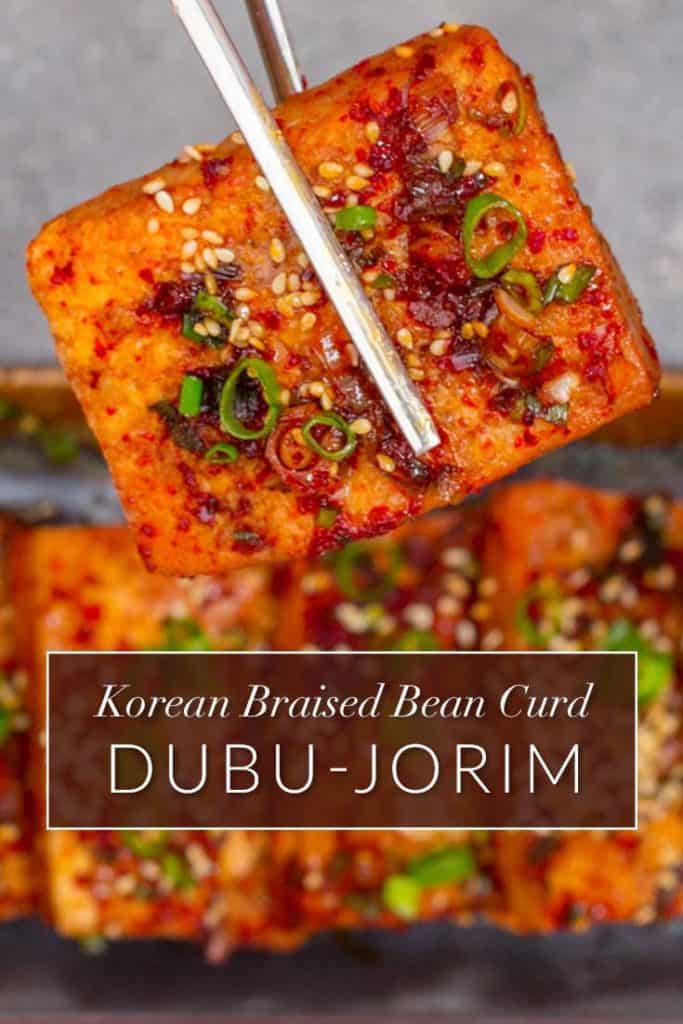
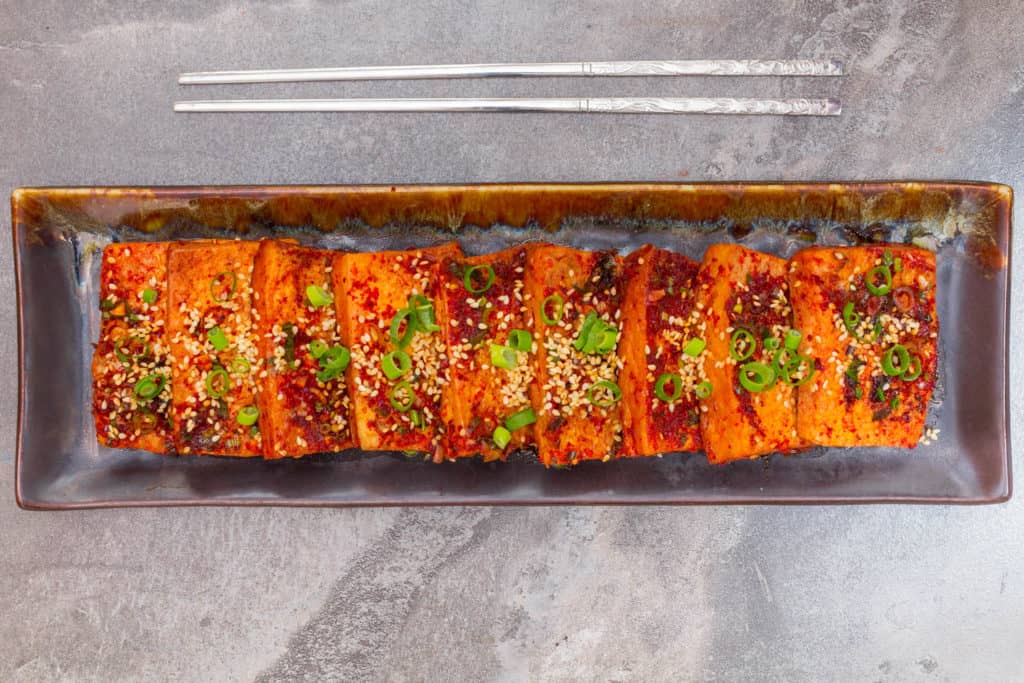
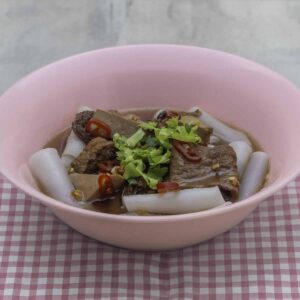
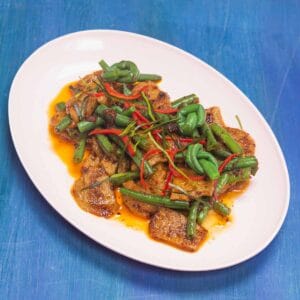

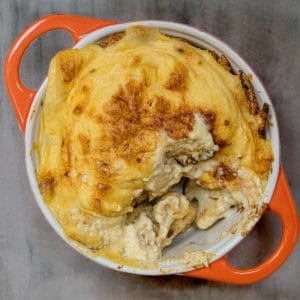
Natalie Linton
Is there a place on your site where you explain boiling the tofu? You mention it in this recipe, but you don't tell us how.
Kip
Hi Natalie,
In the case of this recipe the boiling is already in the instruction, when the tofu is simmering in the braising liquid. Otherwise a pot of water with 1-2% salt is all you need. Bring it to the boil with the tofu in, leave for 15 minutes, and drain on a tea towel for 20 minutes.
Dan Bush
FYI: 75 ml does not equal 2/3 cup - it's more like 2.5 ounces or 1/3 cup. Unfortunately I didn't follow my gut feeling on this and used the 2/3 cup which made it all too watery.
Kip
Hi Dan,
Thanks for pointing out my error. I'm sorry about that. It should be 1/3 cup but I've added more water before and it just takes longer to cook down.
JoAnne
Can you recommend a substitute for gochugaru. I'm so eager to try this recipe and give my tofu dishes a punch of flavor. Thank you.
Kip
Hi JoAnne,
Gochugaru chilli powder is quite fruity and sweet, with a hint of smokiness. I've never made the dish without gochugaru but I've got some ideas... You could use bog standard crushed chilli flakes, but this would make this dish a lot hotter than with the Korean chilli powder. I don't know what your access is like to different types of dried chillies, but I think ground dried guajillo chillies with a wee bit of chipotle would be nice. You could also try using regular chilli flakes and some paprika to cut the heat but maintain the colour.
Hope that helps!
Nick
Try Chipotle or Ancho chili powder.
Kip
I would be wary of Chipotle powder as it has a wholly different flavour profile (and is a lot spicier), but I reckon it would still taste good.
Lutrinae
Just tried this recipe today, and it was both easy and very good 🙂
Thanks for sharing!
Kip
You're most welcome. Glad you liked it!
Cara
Thank you so much for this recipe! We love it! It’s a great accompaniment to many dishes, especially somen. It definitely requires firm tofu (which I didn’t like before this) and I can imagine it being good on a sandwich, too. I was afraid it would be too spicy, but it’s absolutely perfect! Thanks again for the great recipe—I’ll have to try some more on your site too.
Kip
Thank you, Cara, for your kind words! I'm so glad you liked it.
Amy Johnson
I want to make this but bought gochujang instead of gochugaru. Can I use that?
Kip
Hi Amy,
They are entirely different products. Gochugaru is a chilli powder, where as gochujang is a fermented paste with chilli in it. I would opt to replace gochugaru with another type of chilli powder. That said, I don't believe gochujang would made this dish bad, just different. Gochujang is quite sweet, so I would leave both the sugar and salt out of the recipes and then add to taste after you add the paste.
Miriam
Does the tofu need to be pressed before frying in oils?
Kip
No. Just use a good, firm tofu.
U
This recipe looks incredible, thank you so much for sharing!
I have some tofu in the freezer as I really enjoy the spongy texture (and how easy it is to squeeze out the excess water once thawed). Would it be OK to use this thawed and pressed tofu in this recipe? Or would the spongy texture mean that it would soak up too much liquid/not work for braising?
Thank you!
Kip
Great question. I've not made this with frozen and thawed tofu before, but why not give it a try? I reckon it will be good.
Sara
Hi,
Thank you for posting that this recipe feeds 3-4 people. How do we measure/ know what one serving size of the dish is? Also would be great to know things like how much protein, calories, fat... are in the dish.
Kip
Hi Sara,
Thanks for your comment. I don't provide those details for two main reasons. First, I am not a nutritionist and so am not qualified to provide dietary advice. Plus, in addition to calorie counts being off by as much as 200% they offer no insight into how we obtain nutrition from any given food as individuals (so, in essence, the way calorie counting is typically discussed is a food myth). Second, this is not a diet blog. To answer your initial question about portions, I estimate based on experience feeding myself and others. I realise this may mean leftovers for those who eat less than me, or not enough food for those who eat more, but I find this to be the case with recipes from any other the hundreds of cookbooks I cook from too.
Tess
Hi
Tried this and was amazing. Found recipe for 'Shan (chickpea) Tofu' which was nice so might try with this recipe as trying to eat more varied and cutting down on soy. Thanks for recipe!
Kip
Hey Tess,
I'm so glad you enjoyed it! Perhaps I should post some recipes for other types of 'tofu' (in Shan Thai cuisine I have seen it made with both peanuts and rices as well)
Sara B
I had some delicious stuffed beancurd in a restaurant years ago and this is the closest I have come to that flavour. Thanks for the info about boiling beancurd too - I'll be trying that this week!
Kip
I'm so glad you liked it. Thanks for reporting back, and I hope you can find a way to fully recreate that stuffed beancurd experience.
Shannon
Hi there. I made this recipe today and although the tofu got the best of me, (ended up with bite sized pieces rather than slices) it was amazing. I did use the Gochujang paste rather than the Gochugaro (even though I have both) because I need to use up the paste before it goes bad. I didn’t omit any of the sugar etc and it was amazing. I complimented it with kimchi noodle soup and ended up with an amazing meal. I will definitely make this recipe again and again and I may even stuck to the bite sized pieces.
Kip
glad you liked it! Next time I think I'll try bite sized pieces too, now you've mentioned it.
Kate W
I just wanted to say how much I appreciate the 'evidence-based' orientation of your blog as well as the recipes and tips - it's so helpful to understand a bit about the science /why you recommend doing things a certain way. It gives me real confidence - thank you!
Kip
Hi Kate, you are most welcome and also thank you so much for saying this. I really try to make my posts informative and to use language that conveys information rather than fluff and it's nice when someone notices this. That said, if a recipe doesn't work out (or if you have any questions), I always want to know.
Mike Atha
This is super good. Delicious! I didn't have gochugaru but I had taekyung red pepper powder. Same pepper? I used garlic chives that are coming up in the garden and added some chopped coriander because I needed to use it up. I love this dish!
Thank you!
Kip
Ace, glad you liked it! Yeah, taekyung is gochugaru. I bet this was great with garlic chives (I wish I could get them growing well but they always stay tiny whenever I try to grow them!)
Vanessa
Delicious. Our family agreed sauce was needed. We're a saucy family. I'll adjust ingredients in future - the only complaint.
Kip
Saucy family 🤣
I reserve the right to improve malicious and trollish comments.